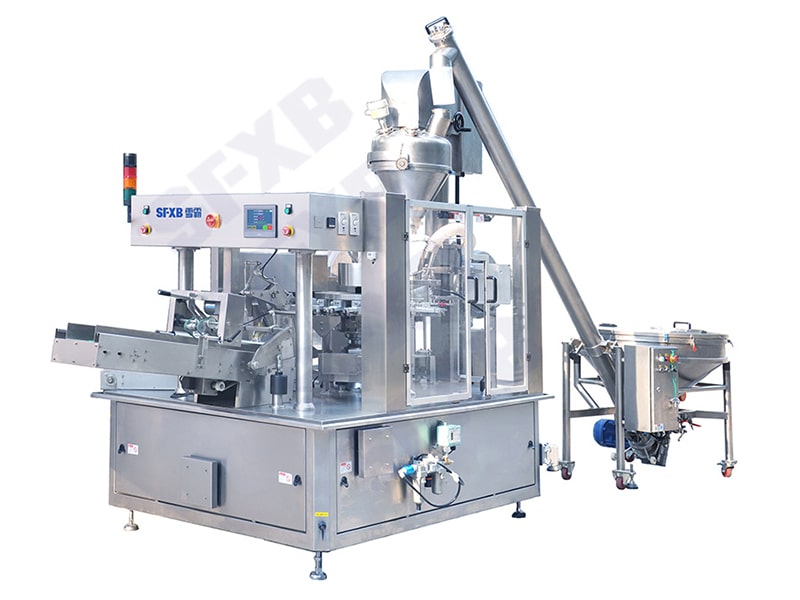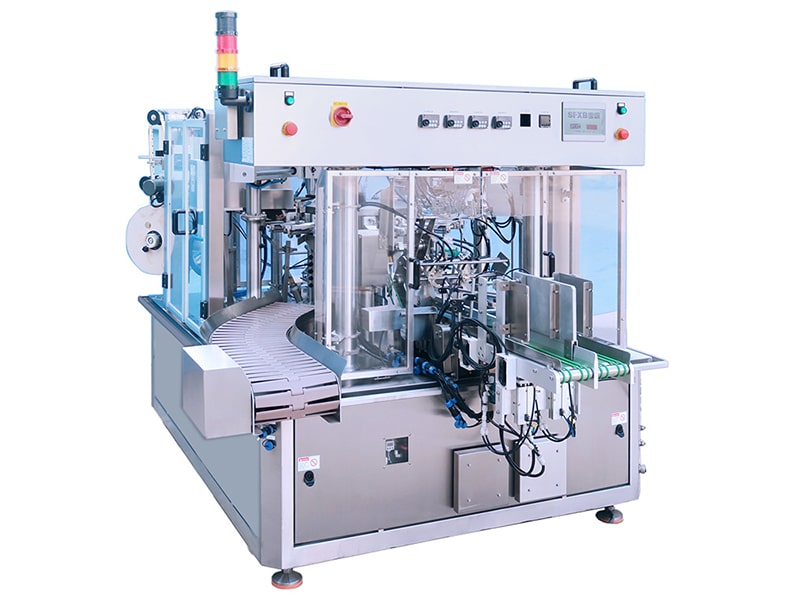In the fast-paced world of modern manufacturing, efficiency and automation are paramount. Bag feeding machines, also known as automatic bagging machines, represent a significant step towards optimized packaging processes.They automate the process of picking, opening, filling, and sealing pre-made bags or pouches, offering significant advantages in terms of speed, efficiency, and consistency compared to manual or semi-automatic methods. Understanding the suitability of bag feeding machines for different packaging types is crucial for manufacturers seeking to streamline their operations and maximize their return on investment. This article delves into the diverse range of packaging types compatible with bag feeding machines, providing a comprehensive guide for those considering their integration into their production lines.
Understanding the Functionality of Bag Feeding Machines
Before exploring the specific packaging types, it’s essential to grasp the fundamental workings of a bag feeding machine. These machines operate on a sequential process:
1.Bag Retrieval and Separation: Bags are stored in a magazine or stack and are individually separated using vacuum suction or mechanical grippers.
2.Bag Opening: The machine precisely opens the bag mouth, ensuring it’s ready to receive the product. This can be achieved through various methods, including air blowing, vacuum suction, or mechanical spreaders.
3.Filling: The opened bag is positioned under a filling station where a predetermined amount of product is dispensed. The filling process is often integrated with weighing or volumetric dispensing systems to ensure accuracy.
4.Sealing: After filling, the bag mouth is sealed using heat sealing, ultrasonic sealing, or other appropriate methods, depending on the bag material and product characteristics.
5.Discharge: The sealed bag is discharged onto a conveyor belt for further processing, such as labeling, coding, or palletizing.
The adaptability of these processes allows bag feeding machines to handle a broad spectrum of packaging materials and product types. However, specific considerations must be taken into account when selecting a machine for a particular application.
 |
 |
| XBGD-60 Eight station bag feeding machine (single bag) | XBGD-60 eight-station bag feeding machine (double bag) |
| Flat bag, zipper bag, stand-up bag and other bag packaging ■ Intermittent 8 -station rotary machine, specially designed for the packaging of flat bags and stand-up bags (zipper or no zipper); touch screen operation, simple and convenient, and intuitive display of error messages; conforms to hygienic standards, and is easy to clean ; ■ A variety of filling devices are available: screw weighing filling device, measuring cup filling device, liquid filling device, paste filling device and other special product filling devices. |
|
Packaging Types Commonly Handled by Bag Feeding Machines
The versatility of bag feeding machines allows them to accommodate a wide variety of packaging types. Here’s a detailed overview:
● Pre-made Open Mouth Bags: This is the most common and widely applicable category. These bags are pre-fabricated with an open mouth for easy filling. They are typically constructed from materials like:
○ Polyethylene (PE): PE bags are a cost-effective and versatile option for packaging a wide range of products, from food items to industrial materials. They offer good moisture resistance and can be easily heat sealed.
○ Polypropylene (PP): PP bags provide higher tensile strength and better clarity compared to PE. They are often used for packaging products that require visual appeal or need to withstand rough handling.
○ Laminated Films: Laminated films combine multiple layers of different materials, such as PE, PP, aluminum foil, and PET, to provide enhanced barrier properties, protection from moisture, oxygen, and light, and improved durability. These are commonly used for packaging food products, pharmaceuticals, and other sensitive items.
○ Paper Bags (with PE or PP lining): Paper bags offer a sustainable and eco-friendly packaging solution. When lined with PE or PP, they provide additional moisture resistance and can be heat sealed. They are commonly used for packaging dry goods, such as flour, sugar, and pet food.
● Pillow Bags: Pillow bags are a simple and cost-effective packaging option characterized by their flat, rectangular shape. They are typically sealed on three sides, with the fourth side being sealed after filling. Bag feeding machines can be configured to handle pillow bags made from various materials, including PE, PP, and laminated films. They are commonly used for packaging snacks, candies, and small hardware items.
● Gusseted Bags: Gusseted bags have folds (gussets) on the sides or bottom, allowing them to expand and accommodate larger volumes of product. These bags are ideal for packaging bulky items like coffee beans, pet food, and fertilizers. Bag feeding machines can be equipped with specialized grippers and bag opening mechanisms to handle the gussets effectively.
● Stand-Up Pouches (SUP): Stand-up pouches have a flat bottom that allows them to stand upright on shelves, providing excellent product presentation. They are commonly used for packaging a wide range of products, including food items, beverages, and personal care products. Bag feeding machines can be designed to handle stand-up pouches with features like zippers, spouts, and resealable closures.
● Side Seal Bags: Side seal bags have seals along the two sides, providing a clean and professional look. They are commonly used for packaging coffee, tea, and spices. Bag feeding machines can be configured to handle side seal bags with precision, ensuring accurate filling and sealing.
● Quad Seal Bags: Quad seal bags have seals along all four corners, providing enhanced stability and durability. They are often used for packaging high-value products or those that require a premium appearance. Bag feeding machines can be equipped with specialized grippers and sealing mechanisms to handle quad seal bags effectively.

Factors to Consider When Selecting a Bag Feeding Machine for Specific Packaging Types
While bag feeding machines offer versatility, several factors must be considered to ensure optimal performance and compatibility with specific packaging types:
● Bag Material: The material of the bag significantly impacts the sealing process. Different materials require different sealing temperatures, pressures, and dwell times. The machine should be equipped with appropriate sealing technology for the chosen material.
● Bag Size and Shape: The bag size and shape determine the dimensions and configuration of the bag feeding mechanism. The machine should be able to handle the specific bag dimensions without causing damage or misalignment.
● Product Type: The type of product being packaged influences the filling method and the bag material selection. Powders, granules, liquids, and solids require different filling systems and bag materials with varying barrier properties.
● Filling Accuracy: The required filling accuracy determines the type of weighing or volumetric dispensing system used in conjunction with the bag feeding machine. High-accuracy filling systems are essential for products with strict weight requirements.
● Production Speed: The desired production speed dictates the machine’s capacity and the speed of the bag feeding mechanism. High-speed bag feeding machines are necessary for large-scale production environments.
● Bag Opening Mechanism: The bag opening mechanism must be appropriate for the bag material and shape. Air blowing, vacuum suction, and mechanical spreaders are common options, each with its advantages and limitations.
● Sealing Method: The sealing method should be compatible with the bag material and the product being packaged. Heat sealing, ultrasonic sealing, and impulse sealing are commonly used options.
● Integration with Other Equipment: The bag feeding machine should be easily integrated with other packaging equipment, such as conveyors, printers, and palletizers, to create a seamless production line.
Let’s explore some of the key packaging applications where bag feeding machines excel:
1. Food & Beverage Industry:
The food and beverage sector is a prime beneficiary of bag feeding technology. The machines can handle a vast array of products, catering to diverse packaging needs and ensuring product freshness and safety.
● Granular & Powdered Products: Coffee beans, ground coffee, spices, sugar, salt, flour, protein powders, instant noodles, and snack foods (like chips, pretzels, and popcorn) are efficiently packaged using bag feeding machines. The precise filling mechanism ensures accurate weight control and minimizes product waste. Furthermore, the hermetic sealing prevents moisture ingress, preserving product quality and extending shelf life. For example, Xueba Pack’s machinery can be configured to handle nitrogen flushing, further enhancing the preservation of sensitive products like coffee.
● Liquids & Pastes: Sauces, dressings, yogurts, jams, honey, and various liquid condiments can be precisely filled into pre-made pouches. Specialized filling nozzles and sealing mechanisms prevent leakage and ensure product integrity during transportation and storage. Sanitary designs and easy-to-clean components are crucial for maintaining hygiene standards within the food industry, a characteristic that Xueba Pack prioritizes in their machine designs.
● Frozen Foods: Frozen vegetables, fruits, meat, and seafood are commonly packaged using bag feeding machines. The rapid filling and sealing capabilities are essential for maintaining the product’s frozen state and preventing thawing during the packaging process. Durable packaging materials resistant to low temperatures are often employed.
● Pet Food: Dry kibble, semi-moist food, and treats for pets are efficiently packaged using bag feeding machines. Accurate weight control is crucial for ensuring consistent portion sizes and meeting labeling requirements. Robust sealing mechanisms prevent leakage and maintain product freshness.
2. Pharmaceutical & Healthcare Industry:
In the pharmaceutical and healthcare industries, precision, hygiene, and compliance are paramount. Bag feeding machines play a crucial role in packaging a wide range of products while adhering to stringent regulations.
● Powdered Medications & Supplements: Pharmaceutical powders, vitamins, and dietary supplements are frequently packaged using bag feeding machines. Accuracy in filling is critical to ensure the correct dosage. The machines often incorporate check-weighing systems to verify the fill weight and reject any bags that deviate from the prescribed limits.
● Medical Devices & Supplies: Syringes, bandages, gauze pads, and other medical supplies are commonly packaged using bag feeding machines. Maintaining a sterile environment is essential. The machines are often integrated with cleanroom environments and use specialized packaging materials to prevent contamination.
● Diagnostic Kits: Components for diagnostic kits, such as reagent strips and testing vials, can be efficiently packaged using bag feeding machines. Accurate counting and precise placement within the pouch are essential for ensuring the functionality of the kit.
3. Chemical & Industrial Sector:
The chemical and industrial sectors also benefit significantly from the efficiency and versatility of bag feeding machines.
● Granular Chemicals & Powders: Fertilizers, pesticides, detergents, and other granular or powdered chemicals can be efficiently packaged using bag feeding machines. The machines are often equipped with dust extraction systems to minimize the risk of airborne particles and ensure a safe working environment.
● Hardware Components: Screws, nuts, bolts, washers, and other small hardware components can be accurately counted and packaged using bag feeding machines. Automated counting systems ensure the correct number of parts are included in each bag.
● Construction Materials: Grout, cement, and other powdered construction materials can be packaged using bag feeding machines. The machines must be robust and capable of handling heavy materials.
4. Other Industries:
Beyond the aforementioned sectors, bag feeding machines find applications in a variety of other industries, including:
● Cosmetics & Personal Care: Samples of shampoos, lotions, creams, and other cosmetic products are often packaged using bag feeding machines.
● Agricultural Sector: Seeds, fertilizers, and other agricultural products are packaged using bag feeding machines.
● Hobby & Craft Supplies: Beads, buttons, and other small hobby and craft supplies are packaged using bag feeding machines.
Benefits of Using Bag Feeding Machines:
The adoption of bag feeding technology offers numerous advantages for packaging operations:
● Increased Efficiency & Productivity: Automating the packaging process significantly increases throughput and reduces labor costs.
● Improved Accuracy & Consistency: Automated filling and sealing ensure consistent weight control and packaging quality.
● Reduced Product Waste: Precise filling mechanisms minimize product spillage and waste.
● Enhanced Product Presentation: Neatly sealed and well-presented packages enhance the product’s visual appeal and brand image.
● Improved Hygiene & Safety: Automated systems reduce human contact with the product, minimizing the risk of contamination.
● Versatility & Flexibility: Bag feeding machines can handle a wide variety of bag types and product forms, offering flexibility to adapt to changing market demands.
Conclusion
Bag feeding machines are versatile and efficient solutions for automating the packaging process for a wide range of products. Understanding the various packaging types that these machines can handle, along with the factors that influence their performance, is crucial for manufacturers seeking to optimize their production lines and improve their overall efficiency. By carefully considering the specific requirements of their products and packaging materials, manufacturers can select the appropriate bag feeding machine to achieve their desired results. As automation continues to play an increasingly important role in modern manufacturing, bag feeding machines will remain a valuable asset for businesses seeking to stay competitive in the global market. Understanding the capabilities and limitations of these machines, as outlined in this comprehensive guide, is the first step towards unlocking their full potential.
SFXB is a leading manufacturer of high-quality bag feeding machines designed to meet the diverse packaging needs of various industries. Our machines are engineered for reliability, efficiency, and ease of operation. With a commitment to innovation and customer satisfaction, SFXB provides tailored solutions to optimize packaging processes and enhance productivity. Visit https://www.xuebapack.com/products/production-line-series-equipment/ to learn more about our range of bag feeding machines and other packaging solutions.






Comments